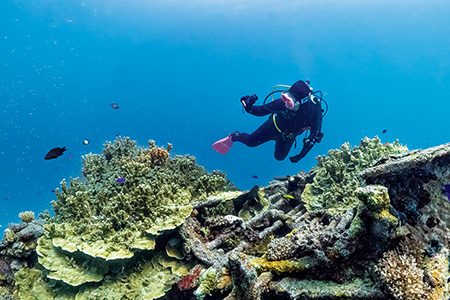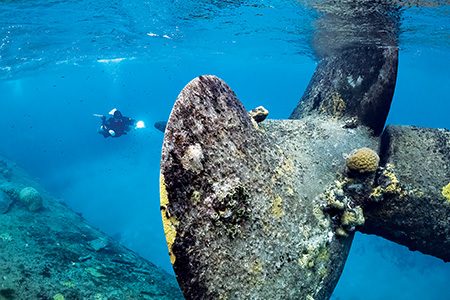My friend Evan Gill pointed across the perfect beach to a spot about 650 feet offshore and casually said, “There’s a Japanese patrol boat from World War II,” as he leaned out of our golf cart. The ocean was an ideal blue and smooth as polished glass, not even lapping against the white sand.
The water was so clear that I saw a small shark weaving through the coral. This place was unbelievable. “It’s a shore dive?” I asked. We both started giggling in delight.
No longer flippant, Evan’s eyes went distant as he gazed across the lagoon. “Seriously, Nat,” he said, “it doesn’t get old.”
Remote and Restricted
I never turn down an adventure, which often works against me. I have found myself lost in the Mexican jungle at night, dangling from a rope under a metal tower in a lightning storm, and even standing in shock as my truck slowly sank beneath the surface of what I thought was a puddle but turned out to be a sinkhole.
But my insatiable curiosity pays off occasionally, and I find myself in sheer awe at my life. How was I lucky enough to stay on a remote military base in the South Pacific, diving various World War II shipwrecks with some of the kindest and most enthusiastic divers I have ever met?
Evan lives on Kwajalein, the largest island in the Kwajalein Atoll and one of several islands in the atoll the U.S. government has leased from the Republic of the Marshall Islands. The U.S. has occupied “Kwaj” since seizing it from the Japanese during World War II. Now part of the Ronald Reagan Ballistic Missile Defense Test Site, the island is home to radar, telemetry, and communications equipment and the specialists who operate it.
This tiny island is one of the few locations involved in maintaining the worldwide GPS system. It’s also home to the Space Fence radar and has served as a base for rocket launches, including for SpaceX. Kwaj is not open to the public, and only personnel actively working to support military efforts may reside on the island.
Divers may briefly land on Kwaj under high security when traveling to Bikini Atoll or Guam, but the island is rarely a destination on its own. Evan had to complete a permission form for me to be able to visit and coach him through his technical dive instructor certifications. In early September 2023, after four flights and about 45 hours of travel, I crossed the international date line and finally arrived at this unusual place.



The Lay of the Land
Evan met me at the airport with a rented golf cart, and we took off on a tour of the 1.2-square-mile (3.1-square-kilometer) island. As we navigated a small road ringing the island, he told me about the rules, warning me not to take photos of “golf balls” — the white geodesic domes that protect the many antennas on the island — or military equipment.
Another rule involved the small airport, whose landing strip occupied an entire side of the island. I was to stop, look both ways, and scan the sky before driving across the landing strip because there are no barriers to prevent people from crossing while a plane is arriving or departing.
During our 20-minute drive around the island, Evan paused to show me key entry points for shore diving along the interior lagoon of the atoll. Each one had a shaded dive shack, freshwater rinse tank, hooks for drip-drying gear, and a table with benches. Tanks and equipment were stashed at these shacks, waiting for their owners to get off work. This clearly is an island of divers.
We stopped by the tank house that stores the scuba cylinders belonging to the island’s dive club. For a nominal annual membership fee, divers can use a passcode to access the tank house any time. The club fees cover unlimited cylinder use and fills — a dive club member fills the tanks every Friday, when most of them are used up. The club had waived my costs for the trip in exchange for a presentation on cave diving, so I had access to the tank house as if I were a member.
The local dive community was welcoming and kind. Mike Bosse, owner of one of the island’s two dive shops at the time, offered to take me on my first ocean dive there while Evan worked on classified government antennas. I just had to meet Mike at the dive site, which was easier said than done.
Evan had rented a golf cart to get me and my four suitcases of gear to our lodgings, but that is not the standard transportation method on Kwaj. Residents use bicycles for general transportation, and when they dive, they connect small, slightly unstable aluminum trailers to the back of the bikes to pull tanks. Having last ridden a bike as a tween, I judiciously made a lap of the island before attaching the trailer with tanks, dive gear, and camera equipment.
Dressed in rainbow-colored dive pants, I bicycled my sidemount gear, two tanks, and Sony Alpha 7S III camera with housing and video lights around a military base, shrieking apologies as I wove my way down dirt roads. “I’m sorry!” I called as I cut off an official-looking gentleman in a government pickup truck. “I’m a danger to myself and others!” He grinned and gave me a thumbs-up. I was glad to make it to the site and meet Mike for the dive.
Underwater Awe
Dropping below the surface on that first dive, I was floored by the healthy staghorn corals swarming with tiny glassfish. Purple and red plate corals were scattered about, and anemones waved their sticky arms at me as I finned along. Dark-blue sea cucumbers dotted the white sand, and a pair of resident eagle rays soared by. After about five minutes I could see the outline of a World War II Japanese patrol boat looming ahead.
Flourishing corals covered the wreck. The top of the wreck sits at about 33 feet (10 meters), and the encrusting sponges and swirling silversides were brilliant in the shallow water. Resting on its side, the boat has significant damage to its port walls, which lets beams of sunlight dance into the ship’s interior.
Mike grinned and hung back while I attempted my first wreck-diving photos. He seemed happy just to visit this beautiful place and waited around for me until my camera battery died. I got so excited that I never made it to the bow.


Another Day, Another Wreck
Determined to swim around an entire wreck on my next dive, I met dive shop owner Viviana del Campo along with her husband, Jacob, and local guide and instructor Cliff Pryor for a few boat dives.
The setup for boat diving on the island is easy. After taking a two-day captain course, residents can rent a small “B-boat” from the marina for a low hourly rate and drive it to one of at least 13 World War II wrecks or various stunning reefs.
We first visited a site called P-buoy — they use a categorial naming system for all the buoys marking the many wrecks — and the wreck of the Akibasan Maru. A U.S. destroyer sank this Japanese cargo ship on Jan. 30, 1944.
The 375-foot (114.3-meter) wreck sits upright on the sandy floor at about 130 feet (39.6 meters), with a mast rising to about 60 feet (18.3 meters). I was awed by the size of the ship, which isn’t even a large wreck for Kwaj, and once again spent so long in one spot that I didn’t make it around the entire site. Unfamiliar with boat parts and artillery, I was transfixed by the lines and shapes created by the wreck’s exposed beams. I fixated on taking photos of what Evan later told me was likely a winch.
Decompression diving and wreck penetration are prohibited when diving from the base. While a few sites have lines independent divers placed while accessing the sites from private boats, we were limited to exteriors or swim-throughs because we were using the base’s B-boats and the dive club’s tanks. Having no previous wreck-diving training or experience, I was fine with this limitation.
From the Akibasan Maru, we headed to the Prinz Eugen, a German heavy-class cruiser. Cliff excitedly filled me in on the ship’s history as we motored to the site. Surrendered to the British Royal Navy at the end of World War II and then transferred to the U.S. Navy in January 1946, the Prinz Eugen was used for nuclear weapons testing at Bikini Atoll. After surviving multiple atomic blasts in Bikini despite some damage and contamination from radioactive fallout, the ship was taken to Kwajalein Atoll, where it capsized on Dec. 22, 1946.
The 681-foot-long (207.7-meter-long) wreck lies upside down near a small island with one of its propellors sticking out of the water. The dive on the Prinz Eugen starts at approximately 16 feet (5 meters) and then progresses along the sloping sand to about 118 feet (36 meters).
As we finned along, with me stopping to excitedly take photos of thick metal cables that made interesting patterns against the daylight, Cliff called me over and pointed to an open hatch. Inside was a closetful of torpedoes. Having received a briefing on dangerous ordnance on wrecks, I needed a minute to muster the courage to swim close enough to look at them.
Bright reef fish followed along as we continued exploring the ship, with Cliff pointing out interesting aspects of the wreck. We turned at the bow and doubled back over the bottom of the ship, where colossal sea fans attached to the wreck’s hull. I could spend weeks on any of these wrecks and probably months just diving the Prinz Eugen, trying to understand it and properly photograph it.
It Never Gets Old
I was in Kwaj primarily to coach my friend, but I returned several times to dive the Japanese patrol boat and the Prinz Eugen. The island has many more fantastic wrecks as well as coral sites and airplane graveyards that I didn’t have time to visit.
With such a variety of dive sites, it could take months of diving to experience all that Kwaj has to offer — and with such a convenient dive setup combined with an enthusiastic and friendly dive community, I wouldn’t mind that one bit. As Evan said at the beginning of my trip, “It never gets old” — a sentiment I now share about diving in Kwajalein.
© Alert Diver — Q1 2024